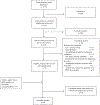Delirium Prevention, Detection, and Treatment in Emergency Medicine Settings: A Geriatric Emergency Care Applied Research (GEAR) Network Scoping Review and Consensus Statement
- PMID: 33135274
- PMCID: PMC7971946
- DOI: 10.1111/acem.14166
Delirium Prevention, Detection, and Treatment in Emergency Medicine Settings: A Geriatric Emergency Care Applied Research (GEAR) Network Scoping Review and Consensus Statement
Abstract
Background: Older adult delirium is often unrecognized in the emergency department (ED), yet the most compelling research questions to overcome knowledge-to-practice deficits remain undefined. The Geriatric Emergency care Applied Research (GEAR) Network was organized to identify and prioritize delirium clinical questions.
Methods: GEAR identified and engaged 49 transdisciplinary stakeholders including emergency physicians, geriatricians, nurses, social workers, pharmacists, and patient advocates. Adhering to Preferred Reporting Items for Systematic Reviews and Meta-Analyses for Scoping Reviews, clinical questions were derived, medical librarian electronic searches were conducted, and applicable research evidence was synthesized for ED delirium detection, prevention, and management. The scoping review served as the foundation for a consensus conference to identify the highest priority research foci.
Results: In the scoping review, 27 delirium detection "instruments" were described in 48 ED studies and used variable criterion standards with the result of delirium prevalence ranging from 6% to 38%. Clinician gestalt was the most common "instrument" evaluated with sensitivity ranging from 0% to 81% and specificity from 65% to 100%. For delirium management, 15 relevant studies were identified, including one randomized controlled trial. Some intervention studies targeted clinicians via education and others used clinical pathways. Three medications were evaluated to reduce or prevent ED delirium. No intervention consistently prevented or treated delirium. After reviewing the scoping review results, the GEAR stakeholders identified ED delirium prevention interventions not reliant on additional nurse or physician effort as the highest priority research.
Conclusions: Transdisciplinary stakeholders prioritize ED delirium prevention studies that are not reliant on health care worker tasks instead of alternative research directions such as defining etiologic delirium phenotypes to target prevention or intervention strategies.
© 2020 by the Society for Academic Emergency Medicine.
Conflict of interest statement
The authors have no relevant financial information or potential conflicts to disclose.
Figures
References
-
- Hustey FM, Meldon SW, Smith MD, Lex CK. The effect of mental status screening on the care of elderly emergency department patients. Ann Emerg Med 2003;41:678–84. - PubMed
-
- McCaig LF, Burt CW. National hospital ambulatory medical care survey: 2002 emergency department summary. Adv Data 2004;18:1–34. - PubMed
-
- De J, Wand AP. Delirium screening: a systematic review of delirium screening tools in hospitalized patients. Gerontologist 2015;55:1079–99. - PubMed
-
- Inouye SK, van Dyck CH, Alessi CA, Balkin S, Siegal AP, Horwitz RI. Clarifying confusion: the confusion assessment method. A new method for detection of delirium. Ann Intern Med 1990;113:941–8. - PubMed
Publication types
MeSH terms
Grants and funding
LinkOut - more resources
Full Text Sources
Medical



